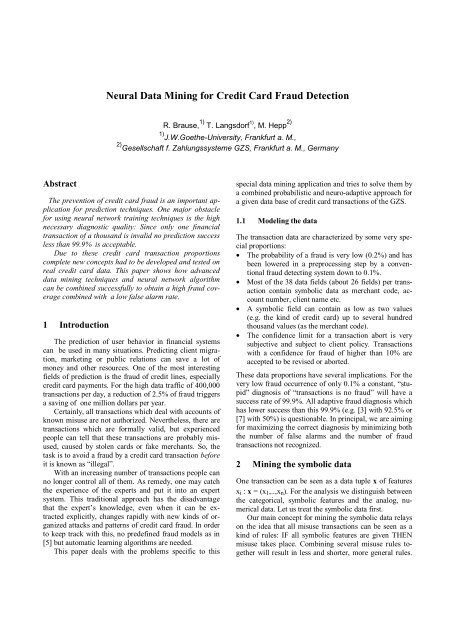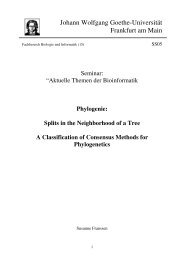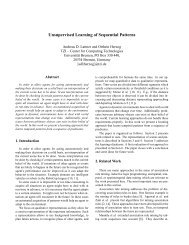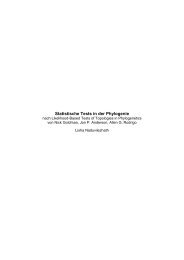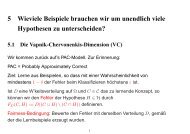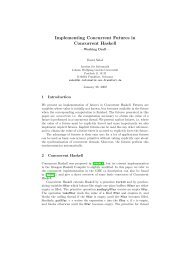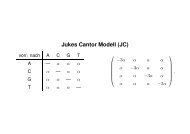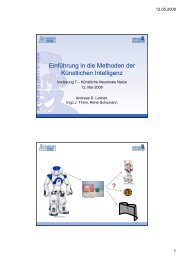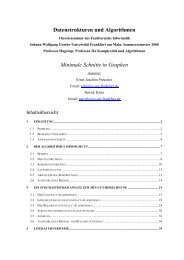Neural Data Mining for Credit Card Fraud Detection
Neural Data Mining for Credit Card Fraud Detection
Neural Data Mining for Credit Card Fraud Detection
Create successful ePaper yourself
Turn your PDF publications into a flip-book with our unique Google optimized e-Paper software.
<strong>Neural</strong> <strong>Data</strong> <strong>Mining</strong> <strong>for</strong> <strong>Credit</strong> <strong>Card</strong> <strong>Fraud</strong> <strong>Detection</strong><br />
R. Brause, 1) T. Langsdorf 1) , M. Hepp 2)<br />
1) J.W.Goethe-University, Frankfurt a. M.,<br />
2) Gesellschaft f. Zahlungssysteme GZS, Frankfurt a. M., Germany<br />
Abstract<br />
The prevention of credit card fraud is an important application<br />
<strong>for</strong> prediction techniques. One major obstacle<br />
<strong>for</strong> using neural network training techniques is the high<br />
necessary diagnostic quality: Since only one financial<br />
transaction of a thousand is invalid no prediction success<br />
less than 99.9% is acceptable.<br />
Due to these credit card transaction proportions<br />
complete new concepts had to be developed and tested on<br />
real credit card data. This paper shows how advanced<br />
data mining techniques and neural network algorithm<br />
can be combined successfully to obtain a high fraud coverage<br />
combined with a low false alarm rate.<br />
1 Introduction<br />
The prediction of user behavior in financial systems<br />
can be used in many situations. Predicting client migration,<br />
marketing or public relations can save a lot of<br />
money and other resources. One of the most interesting<br />
fields of prediction is the fraud of credit lines, especially<br />
credit card payments. For the high data traffic of 400,000<br />
transactions per day, a reduction of 2.5% of fraud triggers<br />
a saving of one million dollars per year.<br />
Certainly, all transactions which deal with accounts of<br />
known misuse are not authorized. Nevertheless, there are<br />
transactions which are <strong>for</strong>mally valid, but experienced<br />
people can tell that these transactions are probably misused,<br />
caused by stolen cards or fake merchants. So, the<br />
task is to avoid a fraud by a credit card transaction be<strong>for</strong>e<br />
it is known as “illegal”.<br />
With an increasing number of transactions people can<br />
no longer control all of them. As remedy, one may catch<br />
the experience of the experts and put it into an expert<br />
system. This traditional approach has the disadvantage<br />
that the expert’s knowledge, even when it can be extracted<br />
explicitly, changes rapidly with new kinds of organized<br />
attacks and patterns of credit card fraud. In order<br />
to keep track with this, no predefined fraud models as in<br />
[5] but automatic learning algorithms are needed.<br />
This paper deals with the problems specific to this<br />
special data mining application and tries to solve them by<br />
a combined probabilistic and neuro-adaptive approach <strong>for</strong><br />
a given data base of credit card transactions of the GZS.<br />
1.1 Modeling the data<br />
The transaction data are characterized by some very special<br />
proportions:<br />
• The probability of a fraud is very low (0.2%) and has<br />
been lowered in a preprocessing step by a conventional<br />
fraud detecting system down to 0.1%.<br />
• Most of the 38 data fields (about 26 fields) per transaction<br />
contain symbolic data as merchant code, account<br />
number, client name etc.<br />
• A symbolic field can contain as low as two values<br />
(e.g. the kind of credit card) up to several hundred<br />
thousand values (as the merchant code).<br />
• The confidence limit <strong>for</strong> a transaction abort is very<br />
subjective and subject to client policy. Transactions<br />
with a confidence <strong>for</strong> fraud of higher than 10% are<br />
accepted to be revised or aborted.<br />
These data proportions have several implications. For the<br />
very low fraud occurrence of only 0.1% a constant, “stupid”<br />
diagnosis of “transactions is no fraud” will have a<br />
success rate of 99.9%. All adaptive fraud diagnosis which<br />
has lower success than this 99.9% (e.g. [3] with 92.5% or<br />
[7] with 50%) is questionable. In principal, we are aiming<br />
<strong>for</strong> maximizing the correct diagnosis by minimizing both<br />
the number of false alarms and the number of fraud<br />
transactions not recognized.<br />
2 <strong>Mining</strong> the symbolic data<br />
One transaction can be seen as a data tuple x of features<br />
x i : x = (x 1 ,..,x n ). For the analysis we distinguish between<br />
the categorical, symbolic features and the analog, numerical<br />
data. Let us treat the symbolic data first.<br />
Our main concept <strong>for</strong> mining the symbolic data relays<br />
on the idea that all misuse transactions can be seen as a<br />
kind of rules: IF all symbolic features are given THEN<br />
misuse takes place. Combining several misuse rules together<br />
will result in less and shorter, more general rules.
Thus, we have to design a generalization mechanism in<br />
order to reduce the dependence of a rule on unimportant<br />
features.<br />
2.1 Generalizing and weighting the association rules<br />
In contrast to standard basket prediction association rules<br />
[1], [2] our goal does not consist of generating long associating<br />
rules but of shortening our raw associations by<br />
generalizing them to the most common types of transactions.<br />
Although generalizations are common <strong>for</strong> symbolic<br />
AI, there are no standard algorithms in data mining to do<br />
this.<br />
How can such a generalization be done? We start with<br />
the data base of fraud transactions and compare each<br />
transaction with all others in order to find pairs of similar<br />
ones. Each pair is then merged into a generalized rule by<br />
replacing a non-identical feature by a ‘don’t-care’-symbol<br />
‘*’. By doing so, a generalization process evolves, see<br />
Fig. 1. Here, the generalization of two transactions with<br />
the feature tuples x 1 = (F,D,C,D,A) and x 2 = (F,D,G,D,A)<br />
(dotted circle) to the rule (F,D,*,D,A) and further up to<br />
(F,*,*,D,A) and to (*,*,*,D,*) is shown. Thus, each generalization<br />
provides at least one ‘don’t-care’-symbol <strong>for</strong><br />
an unimportant feature, increases the generalization level<br />
by one and shortens the rule excluding one feature. All<br />
generalizations which have not been generalized themselves<br />
are the root of the subgraph, <strong>for</strong>ming a tree.<br />
4 th level<br />
3 rd level<br />
2 nd level<br />
F**DA<br />
***D*<br />
***DA<br />
All rules differ from each other. In general, there are<br />
many rules in a level. We define the share of a fraud rule<br />
as the percentage of fraud transactions which is covered<br />
by the rule.<br />
Nevertheless, the share does not reflect the fact that there<br />
are also legal transactions which may fit a fraud rule<br />
leading to a wrong diagnosis. The more transactions with<br />
a correct diagnosis we have the more confidence in the<br />
diagnostic process we get. We define there<strong>for</strong>e the confidence<br />
in a fraud diagnosis as<br />
confidence =<br />
of misuse covered by the rule<br />
# of transactions covered by the rule<br />
# (2.1)<br />
We can show that confidence = 1– P(false alarm) ≤ 1–<br />
P(false alarm|legal). Thus, when the confidence is maximized,<br />
the probability of a false alarm is minimized. For<br />
the rest of the paper, our main goal consists of maximizing<br />
the confidence of a fraud decision <strong>for</strong> an acceptable<br />
probability of fraud detection when fraud is present.<br />
The mining algorithm is described in more detail in [4].<br />
2.2 Results<br />
For the analysis we used a sample set of 5,850 fraud<br />
transactions and 542,858 legal transactions, ordered by<br />
their time stamps. It should be noted that the mining algorithm<br />
has a high runtime complexity. There<strong>for</strong>e, we<br />
used only 30,000 of the legal transactions. The resulting<br />
values <strong>for</strong> the confidence were compared to the whole set<br />
of transactions.<br />
In the following Fig. 2 the per<strong>for</strong>mance of the rule diagnosis<br />
is shown as function of the generalization level.<br />
1 st<br />
FD*DA<br />
CCCD*<br />
0. FDCDA FDGDA FGDDA CCCDA CCCDG<br />
Fig. 1 The generalization graph<br />
For the example of 5850 fraud data, there are 4 generalized<br />
rules in level 16 shown in Table 1.<br />
Rule<br />
ACCT_NBR<br />
TRN_TYP<br />
CURR_CD<br />
POS_ENT_CD<br />
FAL_SCOR<br />
CRD_TYP<br />
1 * EA 840 * * EM 2768 8403184 * 0 1100 * 0 * * * * I * * * 0 * * N * *<br />
2 * EA 840 1) 0 EM * * 563 0 1100 * 0 * * * * I * * * 0 * * * * *<br />
3 * EA 840 * 0 EM 2768 8403184 * * 1100 * 0 * * * * I * * * 0 * * * 002 *<br />
4 * EA 840 * 995 EM * * * 0 1100 * 0 * 0 * * I ¡ * * 0 * * * * *<br />
1) ZZUTSZ1UZZZ1<br />
ICA_CD<br />
AID_CD<br />
SIC_CD<br />
ACT_CD<br />
MSG_TYP<br />
MER_ID<br />
MER_CNTY_CD<br />
CTY_1<br />
POST_CD_1<br />
CNTY_CD1<br />
CR_LMT<br />
ATV_IND<br />
ACCT_STAT<br />
CTY_2<br />
POST_CD_2<br />
ADDR_STAT<br />
EMIT_NBR<br />
INST_NBR<br />
ISS_REAS<br />
GEN_CD<br />
CARD_TYP<br />
Table 1 Generalized transactions with 16 wildcards<br />
The feature names are labeled on the top of the columns.<br />
share<br />
1.2<br />
1.0<br />
0.8<br />
0.6<br />
0.4<br />
0.2<br />
total share<br />
share per<br />
level<br />
total number<br />
of rules<br />
rules per<br />
level<br />
0.0<br />
17 14 11 8 5 2<br />
generalization level<br />
Fig. 2 The per<strong>for</strong>mance of the rule diagnosis<br />
1000<br />
For each generalization level, i.e. <strong>for</strong> each number of<br />
wildcards, a set of active, non-generalized rules exists.<br />
They are denoted as “rules per level”. Each set detects a<br />
certain part of the fraud, measured as “share per level”.<br />
We can see that the main part of the share and the rules<br />
900<br />
800<br />
700<br />
600<br />
500<br />
400<br />
300<br />
200<br />
100<br />
0<br />
number of rules
are obtained <strong>for</strong> level 5 and above. Certainly, the more<br />
rules we take the better we per<strong>for</strong>m. But, the less general<br />
the rules are, the more the per<strong>for</strong>mance will depend on<br />
statistical variations of the fraud data. If we take all the<br />
747 rules from generalization level 4 up to level 17 we<br />
obtain a moderate confidence <strong>for</strong> the fraud detection on<br />
the set of all transactions, see Table 2.<br />
#rules % correct diagnosis confidence<br />
legal fraud total %<br />
747 99.73 90.91 99.64 25.14<br />
(99.72) (25.2)<br />
510 99.97 83.08 99.79 75.17<br />
(99.953) (73.5)<br />
0 99.9 0.0 99.9 0.0<br />
Table 2 <strong>Fraud</strong> detection vs. confidence<br />
However, when we select only those rules which also<br />
preserve their confidence sufficiently on the whole transaction<br />
set, we obtain 510 rules. Certainly, with less rules<br />
the fraud diagnosis probability decreases slightly, but, as<br />
we see in the table, our main goal, the confidence in the<br />
diagnosis, is dramatically increased up to 75 % due to the<br />
high proportion of legal data which are less misclassified.<br />
This is also true when we use the real proportion <strong>for</strong> legal<br />
vs. misuse transactions of 1000:1 which are shown in<br />
round brackets in Table 2. Additionally, the diagnosis<br />
per<strong>for</strong>mance is even better than the constant, “stupid”<br />
diagnosis mentioned be<strong>for</strong>e and noted in the last table<br />
row.<br />
An a l o g d a t a<br />
2-layer<br />
time net<br />
• • •<br />
2-layer<br />
credit net<br />
Decision<br />
misuse<br />
Yes / No<br />
Fig. 3 The neural network experts <strong>for</strong> analog data<br />
We used several networks of the Radial Basis Function<br />
(RBF) type [8], each one specialized on one topic.<br />
3.1.2 The results<br />
Because we have a very low fraud occurrence of only<br />
0.1% the simple constant diagnosis “transactions is no<br />
fraud” will have a success rate of 99.9%. To compete<br />
with this trivial diagnosis, the task of diagnosing a transaction<br />
is not easy to do. If we use only the analog data,<br />
all transactions patterns characterized by n symbolic and<br />
m analog features are projected from the n+mdimensional<br />
space into the m-dimensional space. Generally,<br />
this results in overlapping classes and there<strong>for</strong>e in<br />
diagnostic success far worse than 99.9%. In Fig. 4 the<br />
typical situation is shown <strong>for</strong> the separation of two<br />
classes by one analog variable x.<br />
p(x|L)<br />
p(x|M)<br />
3 <strong>Mining</strong> the analog data<br />
Each transaction is characterized by symbolic and analog<br />
data. So far we have only used the symbolic part of the<br />
transactions. Does the analog part containing transaction<br />
time, credit amount etc. provide any useful in<strong>for</strong>mation?<br />
Will it be possible to enhance the fraud diagnosis?<br />
The problem of fraud diagnosis can be seen as separating<br />
two kinds or classes of events: the good and the<br />
bad transactions. Our problem is indeed a classification<br />
problem. One major approach <strong>for</strong> dynamic classification<br />
with demand driven classification boundaries is the approach<br />
of learning the classification parameters, the classification<br />
boundaries, by an adaptive process. Learning is<br />
the domain of artificial neural networks, and we used a<br />
special model of it to per<strong>for</strong>m the task.<br />
3.1.1 The network<br />
There are several possible network approaches <strong>for</strong> the<br />
task. For our model we used one expert net <strong>for</strong> each feature<br />
group (time, money, etc.) and grouped the experts<br />
together to <strong>for</strong>m a common vote. In Fig. 3 this architecture<br />
is shown.<br />
A<br />
B<br />
Fig. 4 Diagnosis <strong>for</strong> overlapping classes<br />
Here, the two probability density functions p(x|M) <strong>for</strong> the<br />
fraud data and p(x|L) <strong>for</strong> the legal data are shown. For the<br />
best separation probability of the two clusters, the class<br />
boundary is located at point B in Fig. 4 where both densities<br />
are equal. But, <strong>for</strong> our two goals of high fraud detection<br />
success and high confidence in the detection we<br />
encounter a trade-off: If we choose the boundary at point<br />
A we get a high fraud discover probability and a low confidence<br />
(high false alarm rate) whereas <strong>for</strong> a high confidence<br />
we have to choose the class decision boundary at<br />
point C with a smaller fraud discovery success.<br />
Now, let us diagnose one transaction by the means of<br />
the neural network. For that purpose, we used the neural<br />
expert system shown in Fig. 3 and trained it with our<br />
fraud data. We used 300 transactions <strong>for</strong> training and<br />
analyzed the state of the whole network afterwards by<br />
presenting 250 legal and 250 fraud data. The proportion<br />
C<br />
x
of legal to fraud data <strong>for</strong> training was changed, causing<br />
different diagnosing behavior. The results are shown in<br />
Table 3.<br />
proportion<br />
correct diagnosis % faulty diagnosis<br />
%<br />
confidence<br />
total legal fraud legal fraud %<br />
2:1 78.8 95.2 62.4 4.8 37.6 1.3<br />
4:1 58.2 99.6 16.8 0.4 83.2 4.0<br />
10:1 50.0 100 0 0 100 100<br />
Table 3 Shifting the class boundary<br />
As we can see, by augmenting the number of legal transactions<br />
in the training the class boundary shifts towards<br />
point C in Fig. 4. Here, the confidence is high, but the<br />
fraud discovery becomes zero.<br />
4 Combining symbolic and analog in<strong>for</strong>mation<br />
In the previous sections we encountered the fact that the<br />
analog data can not serve as a satisfying criterion <strong>for</strong><br />
fraud diagnosis. There<strong>for</strong>e, we combined the diagnostic<br />
in<strong>for</strong>mation of the rule-based association system of section<br />
2 with the expert in<strong>for</strong>mation of section 3 in a parallel<br />
network including a decision stage. The diagnostic<br />
influence of all the experts are initially the same and converge<br />
by 1:1 training in the limit to their appropriate<br />
value. In all situations, decisions based on the analog data<br />
can override the rule based expert. This is shown as<br />
“combined parallel approach” in Table 4.<br />
Diagnostic Prob. of correct Confidence %<br />
method<br />
diagnose<br />
<strong>Data</strong> set size 1000 11,700 1000 11,700<br />
Rule based .901 .915 100.0 100.0<br />
Analog data .853 .817 1.55 93.1<br />
Comb. par. .928 .898 100.0 1.05<br />
Comb. seq. .845 .876 100.0 81.49<br />
(.9995527) (79.0)<br />
Table 4 Comparing the per<strong>for</strong>mance of different diagnostic<br />
expert systems on two sets of data<br />
The parallel approach results in some extra diagnosis errors<br />
<strong>for</strong> legal transactions which decrease heavily the<br />
confidence down to 1%. Can we change this?<br />
To do this, we also constructed a sequential system.<br />
Here, the decisions <strong>for</strong> “fraud” by the highly successful<br />
rule based expert module are checked additionally by the<br />
analog neural expert. Certainly, this does not decrease the<br />
probability <strong>for</strong> the first stage to classify fraud data as “legal”,<br />
but it increases the probability <strong>for</strong> the diagnosis<br />
“fraud” to be correct and there<strong>for</strong>e increases the confidence<br />
and decreases the number of false alarms, see<br />
Table 4.<br />
In summary, by an automatically generated rule system<br />
we managed to increase the inherent correct diagnosis<br />
of 99.9% to 99.95 %. Including also the analog in<strong>for</strong>mation<br />
we increased this to 99.955%.<br />
As most important topic the fraud decisions are about<br />
80% valid which is quite high <strong>for</strong> this kind of problem.<br />
5 Discussion<br />
In this contribution we developed concepts <strong>for</strong> the statistic-based<br />
credit card fraud diagnosis. We showed that this<br />
task has to be based on the very special diagnostic situation<br />
imposed by the very small proportion of fraud data<br />
of 1:1000.<br />
Additionally, we showed that, by algorithmically generalizing<br />
the transaction data, one may obtain higher levels<br />
of diagnostic rules. Combining this rule-based in<strong>for</strong>mation<br />
and adaptive classification methods yield very good<br />
results.<br />
Based on these results <strong>for</strong> a sample data base, additional<br />
work is necessary to design an online learning diagnostic<br />
system.<br />
References<br />
[1] R. Agrawal, H.Mannila, R. Srikant, H. Toivonen, A.I.<br />
Verkamo: Fast Discovery of Association Rules. In: U.<br />
Fayyad, G. Piatesky-Shapiro, P. Smyth, R. Uthurusamy<br />
(eds.): Advances in Knowledge Discovery and <strong>Data</strong> <strong>Mining</strong>.<br />
Menlo Park, AAAI/MIT Press 1996<br />
[2] R. Agrawal, R. Srikant: Fast Algorithms <strong>for</strong> mining association<br />
rules. Proceedings of the VLDB Conference, Santiago,<br />
Chile, 1994<br />
[3] P. Barson, S. Field, N. Davey, G. McAskie, R. Frank: The<br />
<strong>Detection</strong> of <strong>Fraud</strong> in Mobile Phone Networks; <strong>Neural</strong><br />
Network World 6, 4, pp. 477-484 (1996)<br />
[4] R. Brause, T. Langsdorf, M. Hepp: <strong>Credit</strong> <strong>Card</strong> <strong>Fraud</strong><br />
<strong>Detection</strong> by Adaptive <strong>Neural</strong> <strong>Data</strong> <strong>Mining</strong>, J.W.Goethe-<br />
University, Comp. Sc. Dep., Report 7/99, Frankfurt, Germany<br />
(1999), also by http://www.cs.uni.frankfurt.de/fbreports/07.99.ps.gz<br />
[5] S. Ghosh, D.L. Reilly: <strong>Credit</strong> <strong>Card</strong> <strong>Fraud</strong> <strong>Detection</strong> with a<br />
<strong>Neural</strong>-Network; Proc. 27 th Annual Hawaii Int. Conf. on<br />
System Science, IEEE Comp. Soc. Press, Vol.3, pp.621-<br />
630 (1994)<br />
[6] R.J. Hildermann, C.L. Carter, H.J. Hamilton, N. Cercone:<br />
<strong>Mining</strong> Association Rules from Market Basket <strong>Data</strong> using<br />
Share Measures and Characterized Itemsets; Int. J. of AI<br />
tools vol.7, No.2, pp.189-220, 1998<br />
[7] Y. Moreau, H. Verrelst, J. Vandwalle: <strong>Detection</strong> of Mobile<br />
Phone <strong>Fraud</strong> using Supervised <strong>Neural</strong> Networks: A First<br />
Prototype; Proc. ICANN ´97, Lecture notes on computer<br />
science LNCS 1327, Springer Verlag 1997<br />
[8] S. Haykin: <strong>Neural</strong> networks - a comprehensive foundation,<br />
MacMillan, New York 1994<br />
[9] R. Srikant, R. Agrawal : <strong>Mining</strong> generalized association<br />
rules. Proc. VLDB Conference, Zurich, Switzerland, 1995


